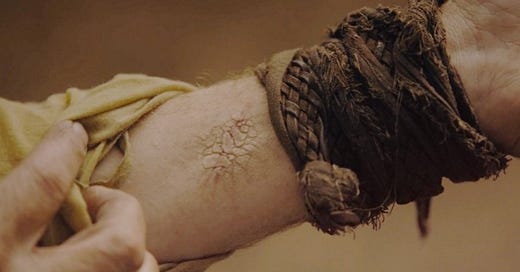S5, E5: Greyscale, Leprosy, and Westerosi World-Building
For a show that features dragons, undead wights, and evil smoke babies, Game of Thrones has always felt surprisingly grounded in reality…
For a show that features dragons, undead wights, and evil smoke babies, Game of Thrones has always felt surprisingly grounded in reality compared to other major works of fantasy. Martin’s tendency to magnify the “behind the scenes” political scheming and power-broking that most fantasy eschews goes a long way in establishing the verisimilitude of Game of Thrones — instead of a giant battlefield conflict between the Starks and Lannisters, Martin gives us Tywin’s expert orchestration of the Red Wedding. The deepest roots anchoring Westeros’ reality and history to our own can be traced to his unique manner of world-building.
Martin’s world-building has been compared to Tolkien’s in its depth and complexity, yet the details each author chose to focus on couldn’t be more distinct. Tolkien expounded upon or outright invented mythological races, crafting distinct cultures and even languages for these people. Elves, orcs, dwarves and trolls all existed in fiction prior to Tolkien, but we owe our modern conceptions of these mythical races to Tolkien’s painstaking yet elegant descriptions in Lord of the Rings (and other works in the series). Perhaps even more impressive, Tolkien invented races such as Hobbits and Ents — completely fictional beings that have become part of the pop-cultural lexicon over the past half-decade.
Still, the interesting part is that the world Tolkien built and the beings who inhabited it seem firmly established as belonging to “fantasy.” This may sound like stating the obvious, but it’s an important distinction compared to Martin’s world of Westeros — and one that ultimately explains why Game of Thrones has captivated the mainstream audience more than Lord of the Rings was ever able to accomplish.
Rather than synthesizing the culture or language of mythological beings, Martin instead populates his world with humans, and roots much of the culture of these people in real-world history. Martin has pointed out that the Red Wedding was inspired by real-life historical events. In a broader sense the conflicts of Game of Thrones have roots in the War of the Roses. In this week’s episode, we see Game of Thrones again drawing parallels to the real world, this time in the realm of medicine.
The affliction of greyscale had been referenced in prior episodes via Stannis’ daughter Shireen, but Kill the Boy provides our first true glimpse at the symptoms of the affliction in its advanced stages. While the Stone Men provide great drama and seem formidable on their own, both the symptoms of greyscale and the way those who contract the disease are treated parallels a real world disease: leprosy.
Like greyscale, leprosy characteristically affects the skin and peripheral nerves causing scaling, disfiguring skin lesions and numbness in affected extremities. Furthermore, the quarantining of those with greyscale (the “stone men”) on Valyria is undoubtedly drawing from “leper colonies” of the middle ages. Of course, since Game of Thrones is ultimately a work of fantasy, Martin amped up the virulence of leprosy and added the end-stage symptom of psychosis that compels the stone men to attack Ser Jorah and Tyrion.
Ultimately, greyscale is just another instance of Martin rooting Westeros in real-world parallels that have ultimately translated into perhaps the most accessible work of fantasy to ever hit the screen. There’s a reason many of the same people who dismissed Lord of the Rings as “nerdish” tune in to Game of Thrones. Rather than putting the traditionally “fantasy” elements front and center, Martin’s story hides them in a Trojan Horse in a world crafted from historical parallels. The ultimate effect is a fantasy show that somehow seems closer to Gladiator than Lord of the Rings, and thus has become the most mainstream work of fantasy in the modern era.
Originally published at raleighco.com on May 14, 2015.




